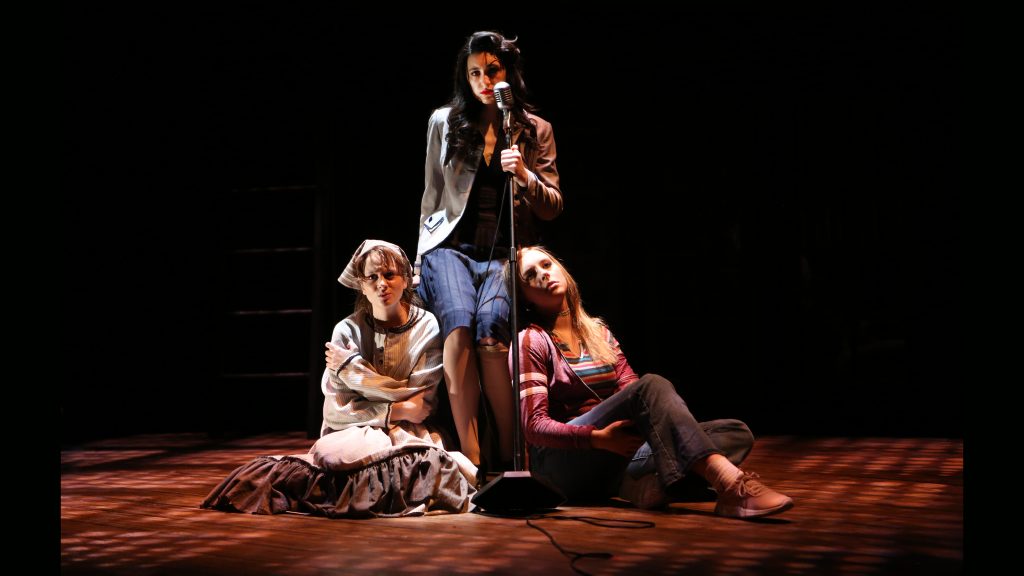
Photo: Sue Kessler
by Em Miller
The space is lit dimly and contemporary pop is playing. A multi-tiered, sparse structure of wood and rusted metal rises from a shallow pit encircled with gravel up to an unsteady-looking platform. A column of thickly braided pink string rises from this platform to a hook on the theater’s ceiling, and from there, splits into a web of smaller, knotted threads and extends outwards above the audience’s heads. These braids represent the fabric that a group of women factory workers in the nineteenth century weave to produce lace, a brutally repetitive task that nearly overwhelms the production’s first act. But the complex network is more than that—it is one of the first things you notice about the space, and it remains there throughout all four acts of the play. Taken symbolically, the thread is the central theme of We Used To Wear Bonnets & Get High All The Time, a physical representation of how all of the characters are deeply connected through time and space, in spite of (or perhaps because of) their struggles and conflicts.
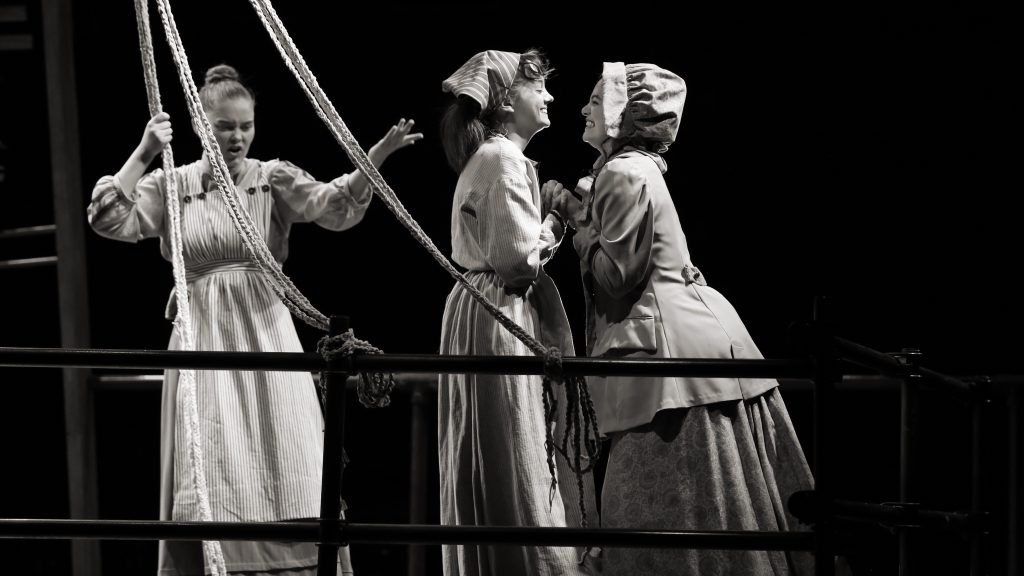
Photo: Sue Kessler
This play is part of a series by director and playwright Julia May Jonas, a set of new works responding to what she calls “male-experience” plays central to the American theater canon that instead focus on women and their viewpoints. Bonnets is a loose adaptation of Eugene O’Neill’s Long Day’s Journey into Night. Jonas has taken the family drama of the original, seized upon the themes of addiction and generational trauma, and expanded it into a work that spans a hundred and twenty years with a large all-female cast. Each act takes place during a different year in the same factory building in New Jersey, from 1890 to 2018 to 1949 to 1992. The characters change, but names are repeated, along with archetypes and social positions in the ensemble: the Laura of 1890 (Sammy Bluth ’19) is an unmarried mother, while the Laura in the ’40s (Olivia Bagg ’19) is a former carnival stripper who now sells pornography, and her counterpart in the modern day (Lulu Fairclough-Stewart ’19) has just left rehab. The themes excavated from O’Neill’s play reappear, with period-appropriate variations, in each act, and are interrogated again and again as the women deal with questions of family, drug and alcohol abuse, sexuality, and their own relationships to each other. Most aspects of the play, from the acting to the writing to the design, work to draw attention to these through-lines of character and historicity. It is challenging to keep in mind every connection and relationship that is explored, but all the actors, from Skidmore Theater veterans to newcomers in the department, impressively embody their characters both with respect to their current situation and the legacies they carry on through other iterations of themselves.
In terms of design, the most striking thing about the production is how visible the theater space and its technology is. The back wall is clearly in view, and there are lighting instruments everywhere, including right in front of the audience. Some of this technology comes from necessity, due to the complexity of the show’s setting and emotional tone. At the very beginning of the play, a row of boxy, dim orange lights behind the set rises, simulating dawn—just one of many powerful moments created by lighting designer Jared Klein. Each time period is located on one of the four visible levels of the stage, each act requires a different atmosphere to distinguish it, and this has been accomplished extraordinarily successfully. In the few moments when time periods intersect and action from another decade spills into the current one, the lighting switches momentarily to indicate the change.
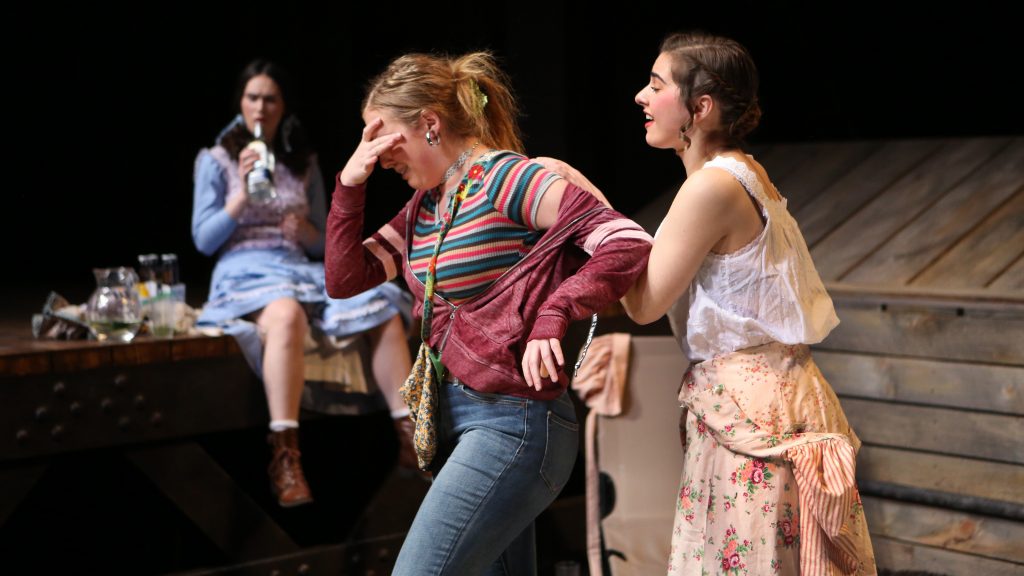
Photo: Sue Kessler
Compared to the relative realism of the lighting, the sound design is exaggerated and stylized. Composed by Brian Cavanagh-Strong, with all other sound cues mixed by Emily Hardy ’21, the production contains almost entirely live music—performed mainly by actors, who have been cast based both on their acting skills and musical talents. The musicians are half-hidden behind windows underneath the highest platform. Most of the sounds they make stand in for crying and screaming children, so their partial invisibility serves the same purpose that the women’s children and siblings do, and provides an external context for their actions without distracting from the events occurring on stage.
Costumes, hair, and makeup (by Samantha Garwood ’14, Esther Hibbs ’20, and Emily Cross ’19 and Megan Muratore ’19, respectively), like the lighting and set design, primarily serve to delineate time period, but also perform the important work of highlighting the repetition of characters. In both of these aspects, just as the actors have, the designers have done excellently. The second act, set in 2018, is focused on women giving tours of the restored factory in period clothing, and there is an immediately obvious distinction between the “authentic” 1890s dresses and low-budget historical reenactment costumes. Aside from period delineations, repeated motifs in presentation give clues as to characters’ connections through time. For instance, the Ediths tend to be distant from the other characters with a slight sense of superiority—a German immigrant in 1890 (Meg Gray ’22) who disdains the struggles of her coworkers, a strict boss at the reenactment factory in 2018 (Jamin Garcia ’20) who knows she is better at her job than everyone else, and a butch bassist in 1992 (Bianca Thompson ’19) who is constantly exasperated by her roommates’ relationships with men. This severity is symbolized by how every iteration wears her hair in a tight bun.
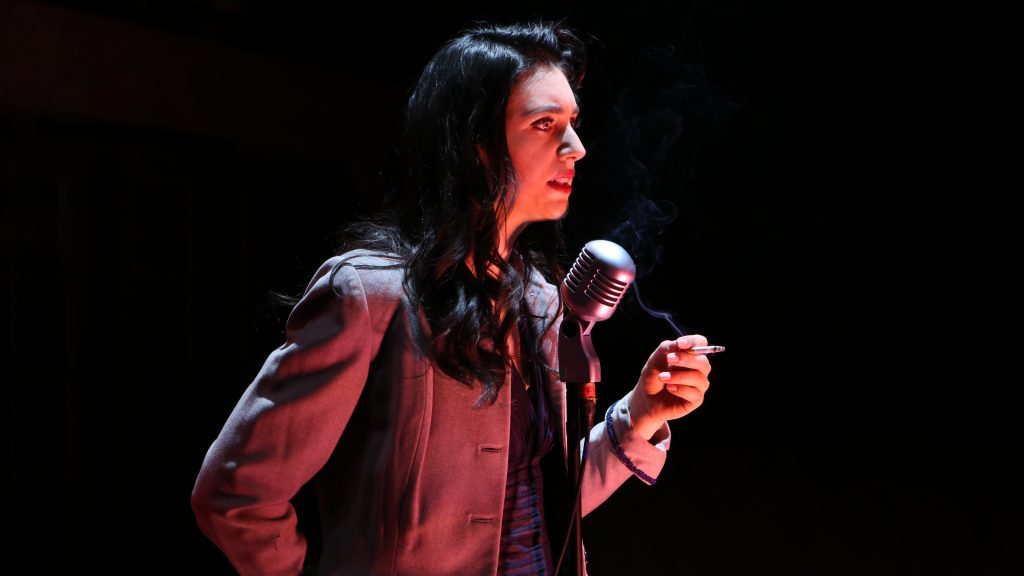
Photo: Sue Kessler
The way in which We Used To Wear Bonnets & Get High All The Time deals with the past anachronistically, demonstrating simultaneously its distance and its nearness, poses a challenge for set design in particular. Scenic designer Sarah Markley ’19 has chosen to separate the stage based on time period, but not restrictively. The four platforms are open, with clearly visible and easily navigable connections to their neighboring spaces. The latter is particularly important for the moments in which actors move between decades, making visible the spillover between past, present, and future. However, even when this spillover exists, it is relatively minimal, especially in the first two acts, and the delineation of time period serves to build up to the final minutes of the play, where the distinctions begin to break down and the interconnectivity of the entire ensemble is laid bare.
Human connection, through love, family, and conflict, is central to the play, and so is the fact that these women’s hardships are exacerbated by their inability to fully realize the degree to which they are linked to each other. The last scene, set in the ’90s, makes this clear; Meg IV (Mia Brierly ’22) invites Rose IV (Jessie March ’21) to dance in their loft, and as they do, the rest of the characters appear on stage to join them while Bianca Thompson ’21, Lily Kops ’22, and Mary Harriman ’20 sing from the pit. The dance viscerally calls upon the emotional impact of each scene in the previous two hours, and reaches its cathartic peak when Brierly and March share a passionate kiss. Then the lights all go out, the stage empties, and the three women from 1992 go to reset the fuse. When they return, all three other Lauras are there to confront them, and the play ends.
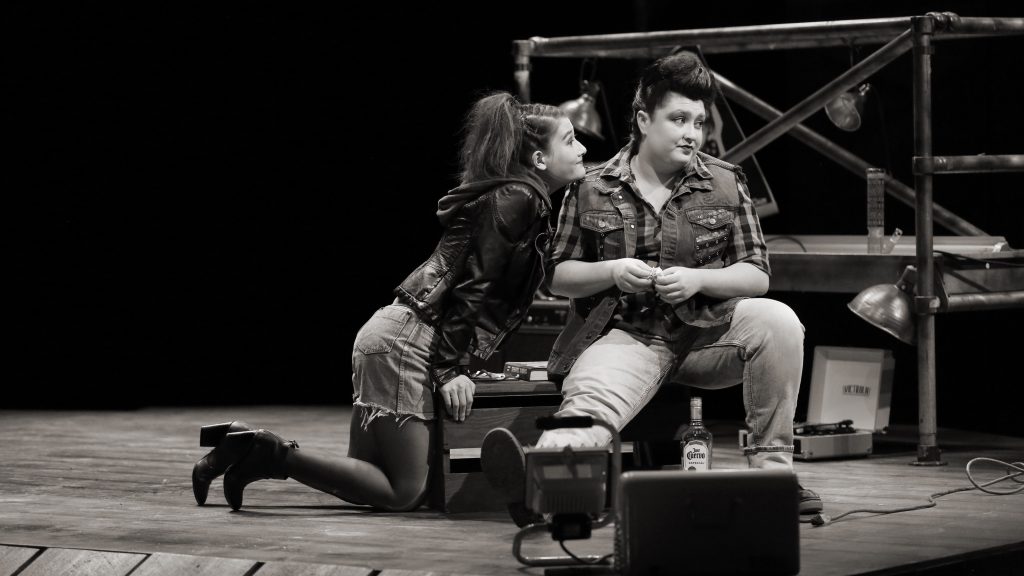
Photo: Sue Kessler
The power and significance of this moment lies in its demonstration that the women, instead of caring for one another, have spent their time pushing each other away and not understanding either their connections or their differences as individuals. They exacerbate their alienation through relying not on each other but on unhealthy relationships with men and with drugs and repudiate patriarchal society by defining one another through these relationships. Although these issues are explored through womanhood specifically, the show makes no essentialist claims about women’s trauma and embodiment, and its questions of community and kinship are relevant to any marginalized group, particularly in an era when bigotry and violence are once more mainstream. We Used To Wear Bonnets & Get High All The Time makes a powerful claim that we can only begin to heal from trauma when we can recognize and make use of the connections we share with others.
PHOTO GALLERY
PRODUCTION CREDITS
Written and Directed by: Julia May Jonas
Assistant Directors: Kallan Dana ’19 and Nina Slowinski ’19
Stage Manager: Romi Moors ’19
Scenic Design: Sarah Markley ’19
Composer: Brian Cavanagh-Strong
Sound Designer: Emily Hardy ’21
Lighting Designer: Jared Klein
Costume Designer: Samantha Garwood ’14
Make-Up Designers: Emily Cross ’19 and Megan Muratore ’19
Hair Designer: L. Esther Hibbs ’20
Choreographer/Dance & Fight Captain: Bianca Thompson ’19
Cellist: Erika Dodge ’20
Bassoonist: Mary Harriman ’20
Cast: Olivia Bagg ’19 (Laura III/Vocal Coach), Sammy Bluth ’19 (Laura I), Mia Brierly ’22 (Meg IV), Kat Collin ’21 (Ollie II), Erika Dodge ’20 (Cellist), Lulu Fairclough-Stewart ’19 (Laura II), Jamin Garcia ’20 (Edith II), Kate Gouran ’20 (Ollie III), Meg Gray ’22 (Edith I), Rowen Halpin ’19 (Meg I/Braiding Captain), Mary Harriman ’20 (Ollie I/Bassoonist), Lily Kops ’22 (Rose I), Izzy Maher ’22 (Meg II), Jessie March ’21 (Rose IV), Liliana Mastroianni ’22 (Rose II), Bianca Thompson ’19 (Edith IV/Choreographer/Dance & Fight Captain)
Crew: Jared Klein (Technical Director), James Varkala (Assistant Technical Director), Jessica Thomas (Scenic Charge & Technical Assistant), Lily DeButts ’21 (Light Board Operator), JoLynn Dubois ’19 (Wardrobe Supervisor) Julia Guy ’19 (Assistant Costumer Designer), Jessie Hamilton ’20 (Assistant Lighting Designer/Assistant Master Electrician), Wynn Lee (Assistant Stage Manager), Michael McDonald ’19 (Assistant Stage Manager), Sarah Markley (co-Paint Charge), Grace Palmer ’22 (Sound Board Operator), Rebecca Rose Shilsky ’20 (Props Master), August Sylvester ’19 (Master Electrician), Sarah White ’21 (Assistant Hair Designer), Goa Zhu ’19 (Assistant Costume Designer)
***
Em Miller is a Junior staff writer for STLN




















